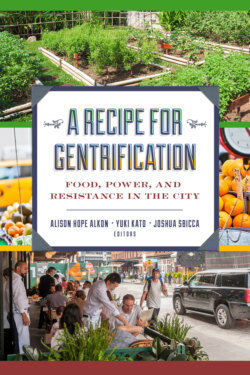A Recipe for Gentrification

Реклама. ООО «ЛитРес», ИНН: 7719571260.
Оглавление
Группа авторов. A Recipe for Gentrification
CONTENTS
Introduction
What Does Food Bring to Gentrification Scholarship?
What Does Gentrification Bring to Food Scholarship?
The Landscape to Come
REFERENCES
PART I. Dining Downtown
1. The Taste of Gentrification
Place and the Social Production of Taste
The Taste of Gentrification
Urban Geographies of Food Gentrification
Authenticity, Democracy, and Community
Conclusion
NOTES
REFERENCES
2. Savior Entrepreneurs and Demon Developers
Durham, North Carolina
Durham’s Food Scene
Savior Entrepreneurs and Demon Developers
Conclusion
NOTES
REFERENCES
3. Making Sense of “Local Food,” Urban Revitalization, and Gentrification in Oklahoma City
Before Revitalization and Local Food in Oklahoma City
The Oklahoma Food Cooperative and the Emergence of Local Food
Catering to the “Creative Class” in Revitalizing Oklahoma City
Stasis: Cooptation and Fetishization
Conclusion: Following Lines of Flight toward Alternate Futures
NOTES
REFERENCES
PART II. Ripe for Growth
4. The Urban Agriculture Fix
Uneven Development and Urban Agriculture Fixes
Recession, Housing Collapse, and Job Loss
Urban Agriculture Interventions for “Sustainable” Development
Reflections on the Strategic Political Marginalization of Urban Agriculture
Conclusion: Fixing Urban Agriculture in an Era of Green Gentrification?
NOTES
REFERENCES
5. From the Holy Trinity to Microgreens
Pamela’s Story
Gentrification of Foodways in the Post-Disaster City
Urban Gardening and Foodways in New Orleans Before 2005
Post-Katrina and the Emergence of New Foodways and Urban Agriculture
New Locals Growing
Framing the New Urban Agriculture Narratives
Engaging the Local Residents and Communities
Growing Local Food
Urban Agriculture and Gentrification of Foodways
NOTES
REFERENCES
6. The Cost of Low-Hanging Fruit?
An Orchard Takes Root in North Portland
A Fruitful Collaboration?
Modes of Communication
Decision-making
Formalizing Volunteers
Management Practices and Aesthetics
Conclusion
NOTES
REFERENCES
7. Gardens in the Growth Machine
The P-Patch Phenomenon
Behind the Scenes: Internal Concerns About Growth
Public Participation: Alignment with Growth Coalition Goals
The P-Patch Gardens Today
NOTES
REFERENCES
PART III. Uneven Alliances
8. Diverse Politics, Difficult Contradictions
San Francisco Urban Agriculture, City Government, and the Formation of the SFUAA
Gentrification in the San Francisco Context
Case Stories from SFUAA. UA Legislation #1: Zoning Changes, 2011–2012
UA Legislation #2: Urban Agriculture Program (2013)
Position on Gentrification (2012)
Urban Agriculture Incentives Zone Act—AB 551 (2013)
AB 551 and (Acceptable?) Land Insecurity
Conclusion
NOTES
REFERENCES
9 “Ethical” Gentrification as a Preemptive Strategy
Restaurant Reviews and Neighborhood Change
The Downtown Eastside: A History of Contentious Politics
Cultural Omnivores in the Downtown Eastside: Constructing the Meaning of Affordable Gourmet Dining in a Low-Income Neighborhood
Social Enterprise in the Downtown Eastside: Restaurateurs “Giving Back” to the Community
Community Resistance to Social Enterprise: Low-Income Residents Redefine Affordability
The Paradox of Caring Capitalism in Low-Income Neighborhoods: How Social Enterprise Preempts Resistance to Gentrification
Conclusion: Ethical Gentrification as a Pathway to Material and Symbolic Dispossession
NOTES
REFERENCES
10 “You Can’t Evict Community Power”
Food Activism and the Question of Gentrification
Saying No to NOBE
From Porta Potties to Permaculture
Oakland Communities United for Equity and Justice
Conclusion
Postscript
NOTE
REFERENCES
PART IV. Growing Resistance
11. Community Gardens and Gentrification in New York City
Naturalized Cultural Norms and Accommodation in Astoria
From Resistance to Displacement in Bed-Stuy
The Community Gardens of East New York: Against Displacement, For Food Justice
Community Gardens and the Politics of Gentrification
NOTES
REFERENCES
12. No Se Vende
Humboldt Park, Chicago
The Food “Frontier” and Social Preservationists
Resisting and Reimagining Gentrification Through Food
Conclusion
NOTE
REFERENCES
13. Black Urban Growers and the Land Question in Cleveland
Historical Geographical Background
Growing on Vacant Land: Perspective of the State
Black Urban Growers in Cleveland: An Epistemic Divide
Urban Renewal: Revitalization, Gentrification, and the Land Question
Conclusion
NOTES
REFERENCES
14. Citified Sovereignty
Desert or Deserted? The South Los Angeles Foodscape
Citified Sovereignty: Autonomous Urban Food Systems in Los Angeles
Community Services Unlimited: Serving the People Body and Soul
Mitigating Green Gentrification and the Non-Profit Industrial Complex
Conclusion
NOTES
REFERENCES
A Conflicted Conclusion
Food and Gentrification in Theory
Food and Gentrification in Praxis
Ways to Combat Gentrification: A Question of Scales of Food Justice
REFERENCES
ACKNOWLEDGMENTS
ABOUT THE EDITORS
ABOUT THE CONTRIBUTORS
INDEX
Отрывок из книги
A RECIPE FOR GENTRIFICATION
Food, Power, and Resistance in the City
.....
Gentrification transforms a neighborhood in many ways. Crime rates decrease, real estate markets expand, infrastructure improves, and new businesses and amenities become available. While some long-term residents can benefit from these changes, displacement limits the extent to which they can take advantage of these positive outcomes. Displacement follows the racialized contours of development as low-income communities of color are increasingly subject to police scrutiny at the behest of new residents (Ospina 2015; Shaw 2015) and are pushed out of their homes, at best resettling in less expensive areas and at worst becoming homeless (Applied Survey Research 2015; Slater 2006). But to focus strictly on the residential and commercial realities of this process would be to miss the significant social and cultural dimensions of displacement (Hyra 2008; Ocejo 2011; Zukin 1987, 2009).
In the public eye, the most notable signs of gentrification are changes in amenities and infrastructure, including artisanal coffee shops, brunch-serving cafes, and farm-to-table restaurants. As the vignettes that begin this chapter indicate, food retail and foodways have become flash points signifying whose food matters. For long-term residents, these changes are not simply economic transitions; they signify the loss of their way of life and sense of local ownership. Because food is such a mundane yet vitally multifaceted part of our everyday lives, it can bring together structural and cultural approaches to the processes, consequences, and trajectories of gentrification that are intimately linked in the popular imagination.
.....